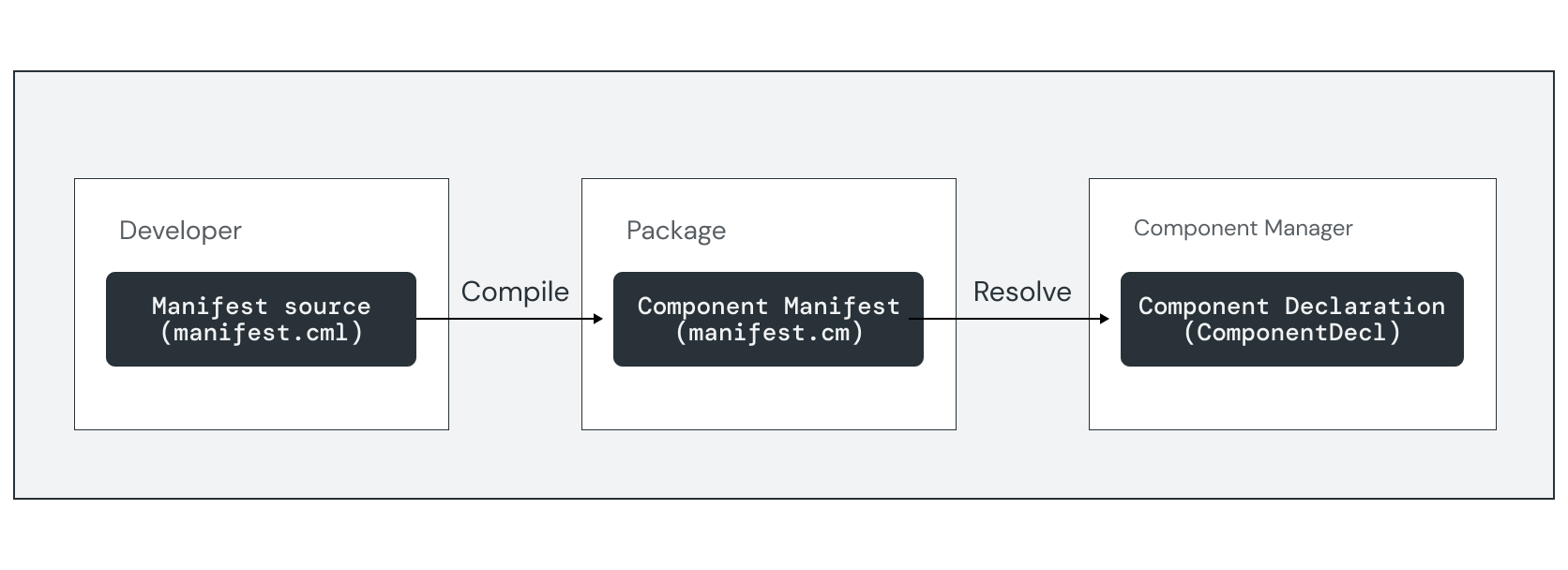每個元件都有宣告,可說明元件的屬性和功能。對於在套件中發布的元件,宣告會使用元件資訊清單檔案表示,並透過元件解析器載入。

您可以使用元件資訊清單語言 (CML) 檔案宣告元件。建立期間
元件資訊清單編譯器 (cmc) 工具會驗證並編譯
將資訊清單來源轉換為二進位格式 (.cm),並儲存在元件的
套件。在執行階段,元件解析器會將二進位元件資訊清單載入 ComponentDecl FIDL 結構,以便為
元件資訊清單
CML 檔案是結尾為 .cml 副檔名的 JSON5 檔案。以下是簡易元件 CML 資訊清單檔案的範例,該元件會執行 ELF 二進位檔,並將「Hello, World」訊息輸出至系統記錄:
{
// Information about the program to run.
program: {
// Use the built-in ELF runner.
runner: "elf",
// The binary to run for this component.
binary: "bin/hello",
// Program arguments
args: [
"Hello",
"World!",
],
},
// Capabilities used by this component.
use: [
{ protocol: "fuchsia.logger.LogSink" },
],
}
這個檔案宣告了元件相關的兩個主要部分:
program:說明二進位檔案等可執行檔資訊 程式引數及相關聯的執行階段在這個範例中,二進位檔會編譯為 ELF 可執行檔,並使用內建的 ELF 執行程式。use:宣告此元件執行所需的功能。在本 舉例來說,fuchsia.logger.LogSink通訊協定可讓元件 傳送至系統記錄 (syslog)。
資訊清單資料分割
某些功能集合代表常見的用途需求 加入系統中的許多元件,例如記錄為簡化在元件中加入這些功能的程序,架構會將這些功能抽象化為可納入 CML 來源檔案的資訊清單區塊。
以下是與前述範例等同的 CML。在這種情況下,您可以透過加入 diagnostics/syslog/client.shard.cml 而非明確宣告 fuchsia.logger.LogSink,提供必要的記錄功能:
{
include: [ "syslog/client.shard.cml" ],
// Information about the program to run.
program: {
// Use the built-in ELF runner.
runner: "elf",
// The binary to run for this component.
binary: "bin/hello-world",
// Program arguments
args: [
"Hello",
"World!",
],
},
}
建構元件
Fuchsia SDK 系統提供 Bazel 規則,可將軟體建構並封裝為 Fuchsia 元件。 Fuchsia SDK 環境 這類規則會在 Bazel 工作區 目錄。
在 Bazel 工作區中,您可以將 Fuchsia 套件和元件宣告為 Bazel 套件中的 Bazel 目標,並由 BUILD.bazel 檔案加以說明。
以下是簡單 C++ 元件的 BUILD.bazel 檔案範例:
# Build rules provided by the Fuchsia SDK
load(
"fuchsia_cc_binary",
"fuchsia_component",
"fuchsia_component_manifest",
"fuchsia_package",
)
fuchsia_cc_binary(
name = "hello_world",
srcs = [
"hello_world.cc",
],
)
fuchsia_component_manifest(
name = "manifest",
src = "meta/hello_world.cml",
)
fuchsia_component(
name = "component",
manifest = ":manifest",
deps = [":hello_world"],
)
fuchsia_package(
name = "pkg",
package_name = "hello_world",
visibility = ["//visibility:public"],
deps = [
":component",
],
)
這個檔案包含下列主要元素:
fuchsia_cc_binary():將 C++ 原始碼編譯為二進位檔,包括 所有必要的程式庫依附元件fuchsia_component_manifest():編譯元件資訊清單檔案來源檔案 (.cml) 轉換為二進位元件宣告,使用cmc。fuchsia_component():將二進位檔、元件資訊清單和其他資源收集到單一目標中。fuchsia_package():元件的分佈單位。允許一或多個元件託管在套件存放區中,並納入目標裝置的套件組合。這個目標會產生套件中繼資料和建構作業 Fuchsia Archive (.far) 檔案。
練習:建立新元件
在本練習中,您將建構並執行能讀取程式的基本元件 並回應系統記錄中的問候語。
首先,請在 Bazel 工作區中為名為 echo 的新元件建立新的專案目錄:
mkdir -p fuchsia-codelab/echo
完成這個部分後,專案應具備下列目錄: 結構:
//fuchsia-codelab/echo
|- BUILD.bazel
|- meta
| |- echo.cml
|
|- echo_component.cc
|- echo_component.h
|- main.cc
BUILD.bazel:可執行二進位檔、元件和元件的 Bazel 建構目標 套件。meta/echo.cml:宣告元件的可執行檔和必要功能的資訊清單。echo_component.cc:C++ 元件功能的原始碼。main.cc:C++ 可執行二進位主項目點的原始碼。
新增程式引數
元件資訊清單檔案會定義元件可執行檔的屬性,包括程式引數和元件功能。
建立 echo/meta/echo.cml 並新增下列內容:
echo/meta/echo.cml:
{
include: [
"syslog/client.shard.cml",
],
// Information about the program to run.
program: {
// Use the built-in ELF runner.
runner: "elf",
// The binary to run for this component.
binary: "bin/echo_example",
// Program arguments
args: [
"Alice",
"Bob",
],
// Program environment variables
environ: [ "FAVORITE_ANIMAL=Spot" ],
},
// ...
}
記錄引數
為主要執行檔建立 echo/main.cc 來源檔案,並新增下列匯入陳述式:
echo/main.cc:
#include <lib/syslog/global.h>
#include <cstdlib>
#include <iostream>
#include <string>
#include "echo_component.h"
為 main() 函式新增下列程式碼:
echo/main.cc:
int main(int argc, const char *argv[], char *envp[]) {
// Read program arguments, and exclude the binary name in argv[0]
std::vector<std::string> arguments;
arguments.resize(0);
for (int i = 1; i < argc; i++) {
arguments.push_back(argv[i]);
}
// Include environment variables
const char *favorite_animal = std::getenv("FAVORITE_ANIMAL");
if (favorite_animal != NULL) {
arguments.push_back(favorite_animal);
}
// Print a greeting to syslog
FX_LOGF(INFO, "echo", "Hello, %s!", echo::greeting(arguments).c_str());
return 0;
}
此程式碼會讀取程式引數,並傳遞至呼叫的函式
greeting() 可產生系統記錄項目的回應。
建立 echo/echo_component.h 和 echo/echo_component.cc,包含
以下程式碼來實作 greeting() 函式:
echo/echo_component.h:
#include <string>
#include <vector>
namespace echo {
std::string greeting(std::vector<std::string> &names);
} // namespace echo
echo/echo_component.cc:
#include "echo_component.h"
#include <numeric>
namespace echo {
static std::string join(std::vector<std::string> &input_list,
const std::string &separator) {
return std::accumulate(
std::begin(input_list), std::end(input_list), std::string(""),
[&separator](std::string current, std::string &next) {
return current.empty() ? next : (std::move(current) + separator + next);
});
}
// Return a proper greeting for the list
std::string greeting(std::vector<std::string> &names) {
// Join the list of names based on length
auto number_of_names = names.size();
switch (number_of_names) {
case 0:
return "Nobody!";
case 1:
return join(names, "");
case 2:
return join(names, " and ");
default:
return join(names, ", ");
}
}
} // namespace echo
此函式會根據提供的引數清單,建立簡易字串 會依照清單長度
新增至建構設定
建立 echo/BUILD.bazel 檔案,並新增下列建構規則,以便納入
新的元件:
echo/BUILD.bazel:
load(
"@fuchsia_sdk//fuchsia:defs.bzl",
"fuchsia_cc_binary",
"fuchsia_component",
"fuchsia_component_manifest",
"fuchsia_package",
"fuchsia_select",
"fuchsia_unittest_package",
)
fuchsia_cc_binary(
name = "echo_example",
srcs = [
"echo_component.cc",
"echo_component.h",
"main.cc",
],
deps = [] + fuchsia_select({
"@platforms//os:fuchsia": [
"@fuchsia_sdk//pkg/fdio",
"@fuchsia_sdk//pkg/syslog",
],
}),
)
fuchsia_component_manifest(
name = "manifest",
src = "meta/echo.cml",
component_name = "echo",
includes = [
"@fuchsia_sdk//pkg/syslog:client",
],
)
fuchsia_component(
name = "component",
component_name = "echo",
manifest = ":manifest",
visibility = ["//visibility:public"],
deps = [":echo_example"],
)
fuchsia_package(
name = "pkg",
package_name = "echo-example",
visibility = ["//visibility:public"],
components = [
":component",
],
)
執行 bazel build,並確認建構作業是否順利完成:
bazel build //fuchsia-codelab/echo:pkg
在下一節中,我們會將此元件整合至建構作業中,並測試 寫入系統記錄

